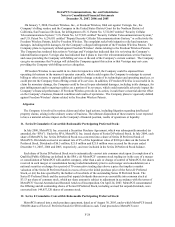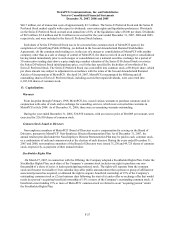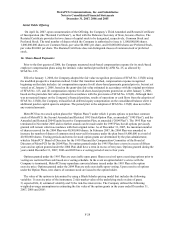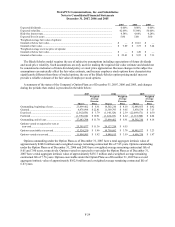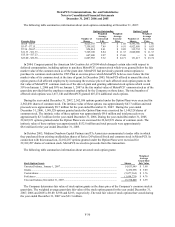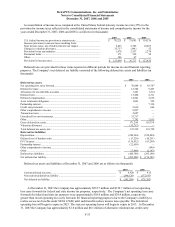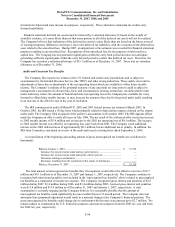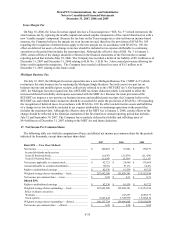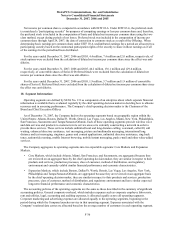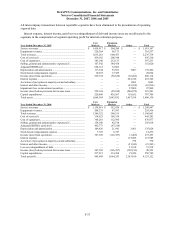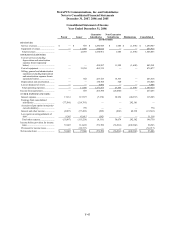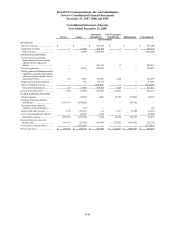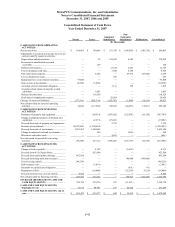Metro PCS 2007 Annual Report Download - page 135
Download and view the complete annual report
Please find page 135 of the 2007 Metro PCS annual report below. You can navigate through the pages in the report by either clicking on the pages listed below, or by using the keyword search tool below to find specific information within the annual report.MetroPCS Communications, Inc. and Subsidiaries
Notes to Consolidated Financial Statements
December 31, 2007, 2006 and 2005
F-36
Net income per common share is computed in accordance with EITF 03-6. Under EITF 03-6, the preferred stock
is considered a “participating security” for purposes of computing earnings or loss per common share and, therefore,
the preferred stock is included in the computation of basic and diluted net income per common share using the two-
class method, except during periods of net losses. Preferred stock was included in the computation of income per
common share through April 24, 2007, the date of conversion to common stock as a result of the Offering. When
determining basic earnings per common share under EITF 03-6, undistributed earnings for a period are allocated to a
participating security based on the contractual participation rights of the security to share in those earnings as if all
of the earnings for the period had been distributed.
For the years ended December 31, 2007, 2006 and 2005, 4.4 million, 7.4 million and 2.0 million, respectively, of
stock options were excluded from the calculation of diluted net income per common share since the effect was anti-
dilutive.
For the years ended December 31, 2007, 2006 and 2005, 44.2 million, 136.1 million and 129.4 million,
respectively, of convertible shares of Series D Preferred Stock were excluded from the calculation of diluted net
income per common share since the effect was anti-dilutive.
For the years ended December 31, 2007, 2006 and 2005, 1.9 million, 5.7 million and 1.9 million of convertible
shares of Series E Preferred Stock were excluded from the calculation of diluted net income per common share since
the effect was anti-dilutive.
18. Segment Information:
Operating segments are defined by SFAS No. 131 as components of an enterprise about which separate financial
information is available that is evaluated regularly by the chief operating decision maker in deciding how to allocate
resources and in assessing performance. The Company’ s chief operating decision maker is the Chairman of the
Board and Chief Executive Officer.
As of December 31, 2007, the Company had twelve operating segments based on geographic region within the
United States: Atlanta, Boston, Dallas/Ft. Worth, Detroit, Las Vegas, Los Angeles, Miami, New York, Philadelphia,
San Francisco, Sacramento and Tampa/Sarasota/Orlando. Each of these operating segments provide wireless voice
and data services and products to customers in its service areas or is currently constructing a network in order to
provide these services. These services include unlimited local and long distance calling, voicemail, caller ID, call
waiting, enhanced directory assistance, text messaging, picture and multimedia messaging, international long
distance and text messaging, ringtones, games and content applications, unlimited directory assistance, ring back
tones, nationwide roaming, mobile Internet browsing, mobile instant messaging, push e-mail and other value-added
services.
The Company aggregates its operating segments into two reportable segments: Core Markets and Expansion
Markets.
• Core Markets, which include Atlanta, Miami, San Francisco, and Sacramento, are aggregated because they
are reviewed on an aggregate basis by the chief operating decision maker, they are similar in respect to their
products and services, production processes, class of customer, method of distribution, and regulatory
environment and currently exhibit similar financial performance and economic characteristics.
• Expansion Markets, which include Boston, Dallas/Ft. Worth, Detroit, Las Vegas, Los Angeles, New York,
Philadelphia and Tampa/Sarasota/Orlando, are aggregated because they are reviewed on an aggregate basis
by the chief operating decision maker, they are similar in respect to their products and services, production
processes, class of customer, method of distribution, and regulatory environment and have similar expected
long-term financial performance and economic characteristics.
The accounting policies of the operating segments are the same as those described in the summary of significant
accounting policies. General corporate overhead, which includes expenses such as corporate employee labor costs,
rent and utilities, legal, accounting and auditing expenses, is allocated equally across all operating segments.
Corporate marketing and advertising expenses are allocated equally to the operating segments, beginning in the
period during which the Company launches service in that operating segment. Expenses associated with the
Company’ s national data center are allocated based on the average number of customers in each operating segment.


